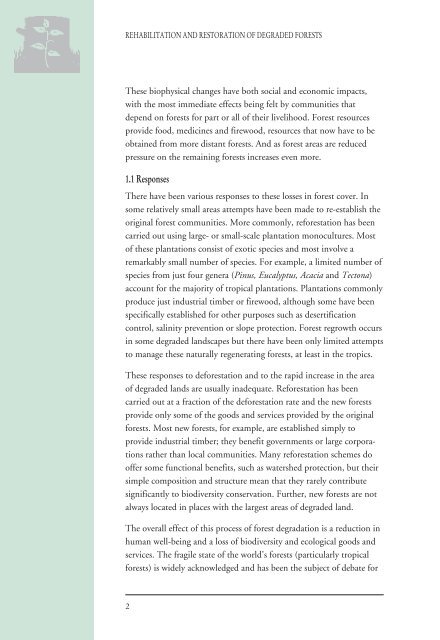Rehabilitation and Restoration Of Degraded Forests (PDF) - IUCN
Rehabilitation and Restoration Of Degraded Forests (PDF) - IUCN
Rehabilitation and Restoration Of Degraded Forests (PDF) - IUCN
You also want an ePaper? Increase the reach of your titles
YUMPU automatically turns print PDFs into web optimized ePapers that Google loves.
REHABILITATION AND RESTORATION OF DEGRADED FORESTS<br />
These biophysical changes have both social <strong>and</strong> economic impacts,<br />
with the most immediate effects being felt by communities that<br />
depend on forests for part or all of their livelihood. Forest resources<br />
provide food, medicines <strong>and</strong> firewood, resources that now have to be<br />
obtained from more distant forests. And as forest areas are reduced<br />
pressure on the remaining forests increases even more.<br />
1.1 Responses<br />
There have been various responses to these losses in forest cover. In<br />
some relatively small areas attempts have been made to re-establish the<br />
original forest communities. More commonly, reforestation has been<br />
carried out using large- or small-scale plantation monocultures. Most<br />
of these plantations consist of exotic species <strong>and</strong> most involve a<br />
remarkably small number of species. For example, a limited number of<br />
species from just four genera (Pinus, Eucalyptus, Acacia <strong>and</strong> Tectona)<br />
account for the majority of tropical plantations. Plantations commonly<br />
produce just industrial timber or firewood, although some have been<br />
specifically established for other purposes such as desertification<br />
control, salinity prevention or slope protection. Forest regrowth occurs<br />
in some degraded l<strong>and</strong>scapes but there have been only limited attempts<br />
to manage these naturally regenerating forests, at least in the tropics.<br />
These responses to deforestation <strong>and</strong> to the rapid increase in the area<br />
of degraded l<strong>and</strong>s are usually inadequate. Reforestation has been<br />
carried out at a fraction of the deforestation rate <strong>and</strong> the new forests<br />
provide only some of the goods <strong>and</strong> services provided by the original<br />
forests. Most new forests, for example, are established simply to<br />
provide industrial timber; they benefit governments or large corporations<br />
rather than local communities. Many reforestation schemes do<br />
offer some functional benefits, such as watershed protection, but their<br />
simple composition <strong>and</strong> structure mean that they rarely contribute<br />
significantly to biodiversity conservation. Further, new forests are not<br />
always located in places with the largest areas of degraded l<strong>and</strong>.<br />
The overall effect of this process of forest degradation is a reduction in<br />
human well-being <strong>and</strong> a loss of biodiversity <strong>and</strong> ecological goods <strong>and</strong><br />
services. The fragile state of the world’s forests (particularly tropical<br />
forests) is widely acknowledged <strong>and</strong> has been the subject of debate for<br />
2

















